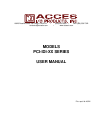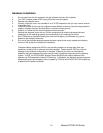Chapter 1: Introduction
Features
• Individually-Isolated AC/DC Inputs for up to Three 16-Bit Groups, 48 total.
• Reverse Polarity protection
• AC Filtering
• Optical Isolation, Channel-to-Channel and Channel-to-Host PC.
•
Change-of-State detection (certain models).
Description
This series of cards provide as many as 48 optically-isolated inputs for AC/DC signals with Change-of-
State (COS) Detection capability. Each input is reverse polarity protected and rectified by photo-coupler
diodes. Standard 12/24 AC control transformer outputs can be accepted as well as DC voltages. The
input range is up to 60VDC or AC rms at frequencies of 40 to 10kHz.
Each input circuit contains a switchable filter that has a 4.7 millisecond time constant (without filtering, the
response is less than 30 microseconds). The filter must be selected for AC inputs in order to eliminate the
on/off response to AC. The filter is also valuable for use with slow DC input signals in a noisy
environment. The filter may be switched out for DC inputs in order to obtain faster response. Filters are
individually selected by jumpers. See Figures 1-1 and 3-1 for jumper arrangements.
The Change-of-State (COS) Detection capability (denoted by a “C” after the model number) provides a
means to automatically interrupt the host computer in real time. When one or more input bits change
state, a PCI interrupt is generated. That interrupt, in turn, can be used by your application program to
initiate a poll of the inputs, then signal appropriate alarms, and/or initiate scan of other I/O points that
have not been previously activated. This can greatly simplify your application program and eliminate need
to continuously poll inputs. COS Detection is enabled/disabled for all 3 groups of 16 bits. Chapter 5
describes the programming aspects of the COS feature.
These cards provide a much lower cost per point than externally-mounted, optically-isolated, solid-state
modules or PLCs. Input connections are via ribbon-cable headers on the card, and a tie-down bar is
included to provide strain relief for those cables.
These cards are especially useful in applications where high-common-mode external voltages are
present as found in factory automation, energy management, security systems, and process monitoring
applications. In addition to protecting your computer from accidental contact with high external
voltages, the isolation provided eliminates troublesome ground loops.
There are 48-bit, 32-bit, and 16-bit versions. The latter two models are de-populated versions of the
48-bit card. Further, letters are appended to the model numbers to signify options included on the
card. Refer to Table 1-1 for model specific information.
Manual PCI-IDI-XX Series 5


















